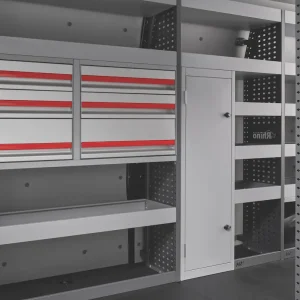Unleashing the first-generation Raptor on the unsuspecting UK pick-up market was an unbridled success for Ford.
While not quite usurping the Wildtrak for popularity, largely due to its lower payload and non-commercial vehicle status when reclaiming VAT, it has underlined our love for potent- looking pick-ups. Yet, the first Raptor wasn’t actually any more powerful under the bonnet than a standard top-spec Ranger. That though, has changed with Raptor version two and its V6 petrol engine producing 289hp and 491Nm of torque.
The 210hp 2.0-litre diesel used in the first Raptor will remain on sale as the entry-level option for the Raptor range, while the V6 diesel promised when the Raptor was launched earlier this year will be reserved for the standard Ranger line-up – that will follow the March 2023 arrival of the Raptor on UK roads when it appears in the second half of the year.
For now, though, the Ranger it is all about the new range-topping petrol V6 in the Raptor which, although not quite as ludicrous as the V8 of the US spec Ford F150 Raptor, whose C-shaped headlights the Ranger Raptor imitates, it still manages to deliver quite a punch thanks to a new anti-lag system first used on the Ford GT racing car.
The system keeps pressure in the turbochargers for up to three seconds so that power can quickly be restored, enabling you to back-off the throttle, for example when entering a corner, before accelerating away with pressure in the turbo. It makes power delivery quicker and smoother and is quite effective for maintaining momentum when off-roading too.
Mindful that this is, in theory, a commercial vehicle, the engine has been toughened up with a graphite-iron cylinder block that is said to be 75% stronger and stiffer than the iron used in a regular engine. This is all down to the work of Ford Performance, the Australian development team that designed and tuned the previous Ranger Raptor. They’ve once again worked their magic here, overhauling the suspension and steering as well as the engine and appearance.
Fox 2.5-inch Live Valve dampers are the new hot topic for the Raptor. They provide position-sensitive damping, which means the Raptor is even more comfortable on the road but able to endure far greater levels of impact whether that be from off-roading, or simply crashing through a pothole. The first-generation Raptor was already exceptionally good on the road, but the new springs are a big leap forward in comfort largely due to an increase in rebound dampening at the front. There’s none of the nodding feeling that the previous model suffered from.
Faster steering makes the Raptor more agile than before and has improved the handling and driver feedback. It helps off-road but is far more noticeable on-road where the better handling and more power makes it a really dynamic vehicle to be in. That’s impressive considering its size, which has also increased by 50mm in the width. The front wheels have also been moved further forward, increasing the wheelbase by 50mm and shortening the front overhang. Both of which help with its off-roading ability, but not as much as the addition of a new standard front and rear locking rear differential and four pre-set selectable off-road modes – Rock Crawl, Mud/Ruts, Sand and Baja – in addition to the Normal, Sport and Slippery on-road settings.
The modes can be selected though a rotary dial on the console near the 10-speed automatic transmission, but settings can also be tweaked on the steering wheel controls. The previous Raptor had steering-mounted mode controls, but there’s now a full range of customisation available on the wheel with settings for steering sensitivity and suspension as well as exhaust noise which can be changed from Normal to Quiet as well as a Sport setting and an extra loud Baja sound. There’s now also a Raptor “R” button for saving your preferred settings and activating them with one quick press.
Rock Crawl does what you’d expect and is for very slow uneven ground. Sand changes the gearbox settings for fast changes and quicker power delivery in soft surfaces like sand and snow while the Mud/Ruts setting enhances grip and automatically engages the rear differential. The famous Baja setting also remains and continues to let you feel like a driving hero on sand or other slippery surfaces while still giving you enough assistance systems to keep you safe. It also automatically turns the exhaust note to high and softens the suspension to let you really maximise the Fox dampers to attack the terrain with maximum speed.
There’s very little not to like about the Ranger Raptor, including the splashes of Code Red colour details around the cabin, which also gets a massive digital instrument cluster, a fantastic ten-speaker B&O sound system and 12-inch portrait touchscreen which becomes nerve centre of the off-road settings when in modes like Rock Crawl as well as doing all the infotainment functions.
The 652kg payload is the only real negative, along with the £57,960 on the road price, but for your many Raptor customers neither is likely to be an issue.
Ford Ranger Raptor V6
Price £57,960 (inc VAT)
Insurance tbc
Warranty tbc
Service intervals tbc
Load length 1,564mm
Load width 1,224mm
Gross payload 652kg
Engine/power 3-litre, V6 petrol with 289hp, 491Nm
Max speed 111mph
0-62mph 7.9
Combined consumption 20.4mpg (WLTP)
Towing capacity 2500kg (braked)
CO2 315g/km





